King’s Hall Health & Wellbeing Park, Belfast
With placemaking at its heart, King’s Hall Health & Wellbeing Park in Belfast, Northern Ireland, sets a benchmark for community-integrated health and social care. TODD Architects has been working with healthcare developer Benmore Octopus on the design of the masterplan to regenerate the Kings Hall site as part of a dynamic residential, lifestyle, leisure and wellbeing park.
Alongside a range of primary healthcare services, life sciences and early-years learning, the Kings Hall site has senior residential and nursing care, as well as assisted living spaces providing transitionary and specialist care. All of this is set amidst a thriving, multigenerational environment of eateries, retail and leisure facilities and sited close to an established community.
The park improves access to healthcare services for patients, provides much-needed quality retirement living and acts as a hub for life sciences companies in the south of the city. It will also help protect and preserve the iconic King’s Hall building that once played host to music acts as diverse as the Beatles and U2 and was the setting for boxer Barry McGuigan’s first title defence in 1985.
The masterplan
King’s Hall Health & Wellbeing Park is located 3.5 miles from Belfast City Centre in South Belfast on the site of the former Kings Hall and Balmoral Showgrounds. The immediate area is mixed in character and includes high-quality residential and retail/restaurants located close by on the Lisburn Road.
Our masterplan for the Health & Wellbeing Park was developed in close collaboration with the developer and Belfast City Council, extensively engaging with various healthcare stakeholders and the local community.
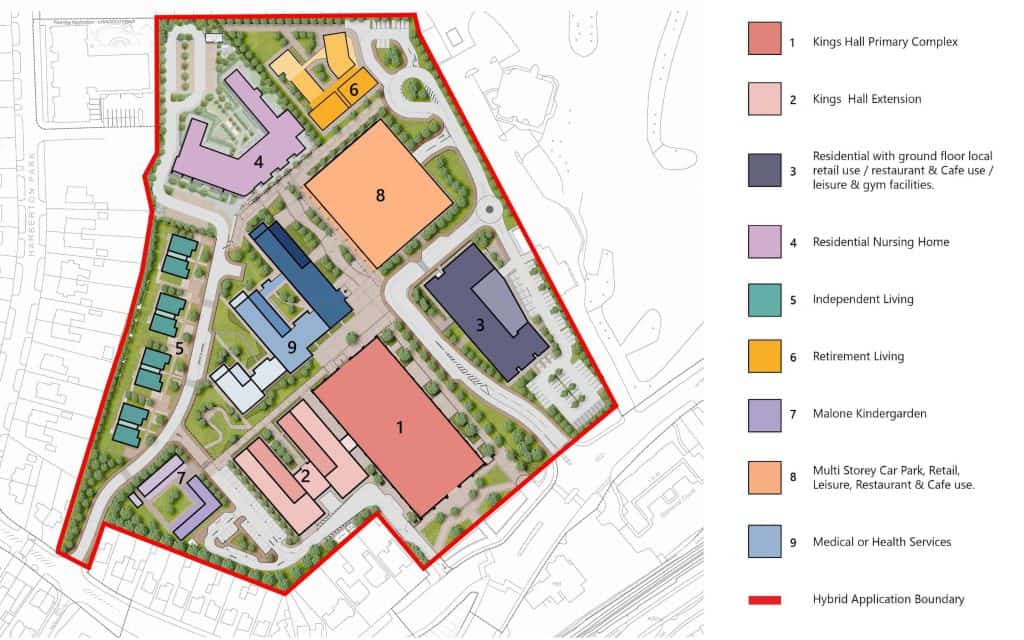
The King’s Hall (Plot 1)
The King’s Hall, built in 1933 as a permanent exhibition hall for the Royal Ulster Agricultural Society, is a listed building and a well-known landmark both locally and regionally. The wider redevelopment not only advanced various new components within the site, but also supported the renovation and adaptive reuse of this heritage asset for the planned provision of Primary Care and Support Facilities over a number of levels within the existing building.
The new accommodation is conceptually treated as ‘insertions’ within the large open volume. To experience the original scale of the building, the added services are provided in new elements along each side of a tall, open central space. Practices are accessed via a new central feature stair and lift core, with views into the central atrium. The ground floor is conceived as an extension of the new central Plaza, with medical support services such as Pharmacy and Opticians envisaged.
The building has active uses addressing both the external street and proposed internal mall, continuing the theme of a place for interaction for both the campus residents and the visiting community
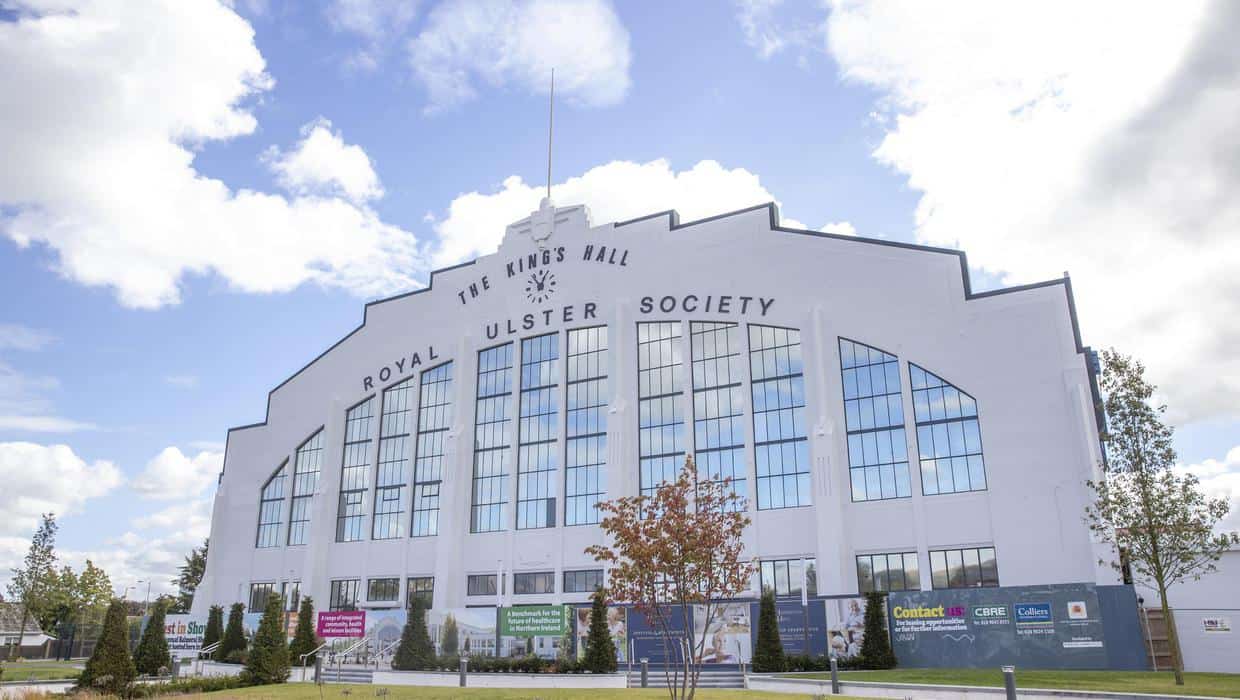
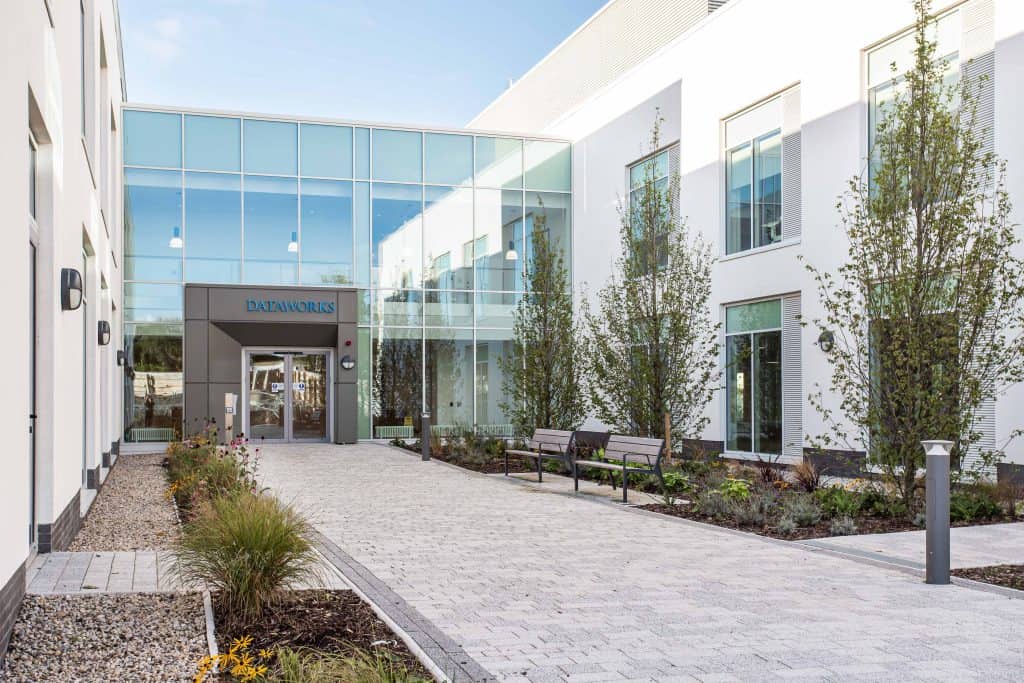
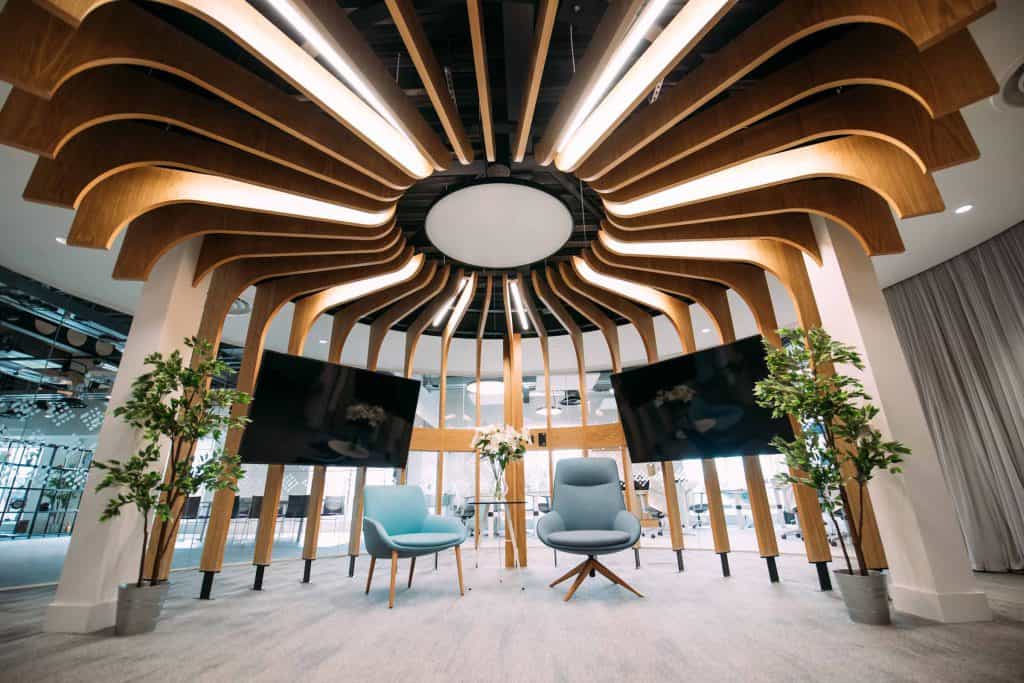
Dataworks – The Extension to the King’s Hall: (Plot 2)
Subservient in scale to the listed King’s Hall building, the extension is two stories in height with an additional plant level above. The building has been designed with potential for ground-floor linkage into the main King’s Hall.
Developed speculatively for a range of healthcare tenants, the design needed to consider flexibility in its offer. The plan is simple and served off a central entrance core which accommodates a double-height entrance foyer, stairs, lifts, WCs and showers.
The building template was developed to maximise its use for a range of potential end-users and tenants. Proof of its success is that the building is now fully let with a range of associated medical uses, these include A Medical Data Analytics PLC, Private Healthcare providing a range of services from Consultation to Day procedures.
Associated Medical & Health Services (Plot 9)
Following on from the success of the extension to the King’s Hall and the market demand from a range of healthcare providers in Dataworks, our client is currently at the early stages of development of this Plot. However, the building elements range in scale, both in terms of floor plate and height/scale to allow the building to suit a wide range of potential occupiers.
Located adjacent the listed King’s Hall, it is designed to respectfully echo its scale, materiality and detailing. The main entrances are located beside the northern gable of the King’s Hall along with a newly planned ‘dwell’ space. The main portion of this accommodation faces onto and forms a built edge to the new Central Plaza space.
Residential with ground floor Local Retail (Plot 3)
Located at the entrance to the campus, this block provides new residential accommodation and also ‘frames’ the new main entrance road and plaza. The scale has been carefully considered to ensure the building is respectfully lower in height than King’s Hall with generous separation distances between the two, to enhance the ’setting’ of the listed building.
This plot provides a range of tenures with social and affordable accommodation for elderly residents.
An active use is incorporated within the ground floor of the development, consciously adding to the vibrancy of the development.
Residential Nursing Home (Plot4)
The four-storey Nursing Home was developed in close liaison with an experienced Residential Care Home Operator. The offer allows for care of the elderly in a safe, supported environment
The building has been designed around landscaping to create a series of differing external spaces, including sensitive secure gardens with active supervision. It is located at a key point in the masterplan and frames views at the end of the plaza and at the end of the roadway serving the main residential portion of the site. The ground-floor uses to the plaza edge have been designed to allow communal and social interaction for visitors to the residential nursing home.
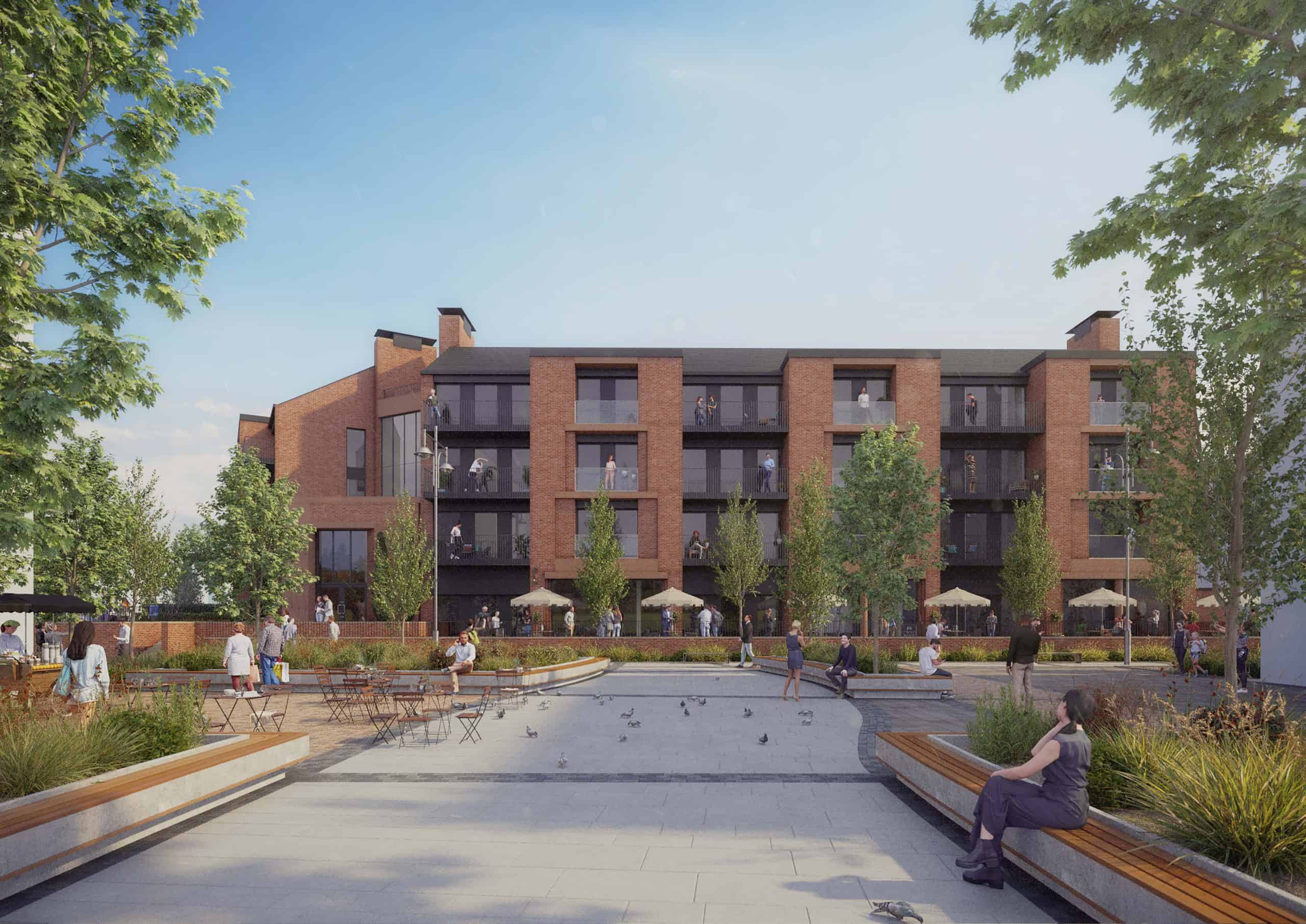
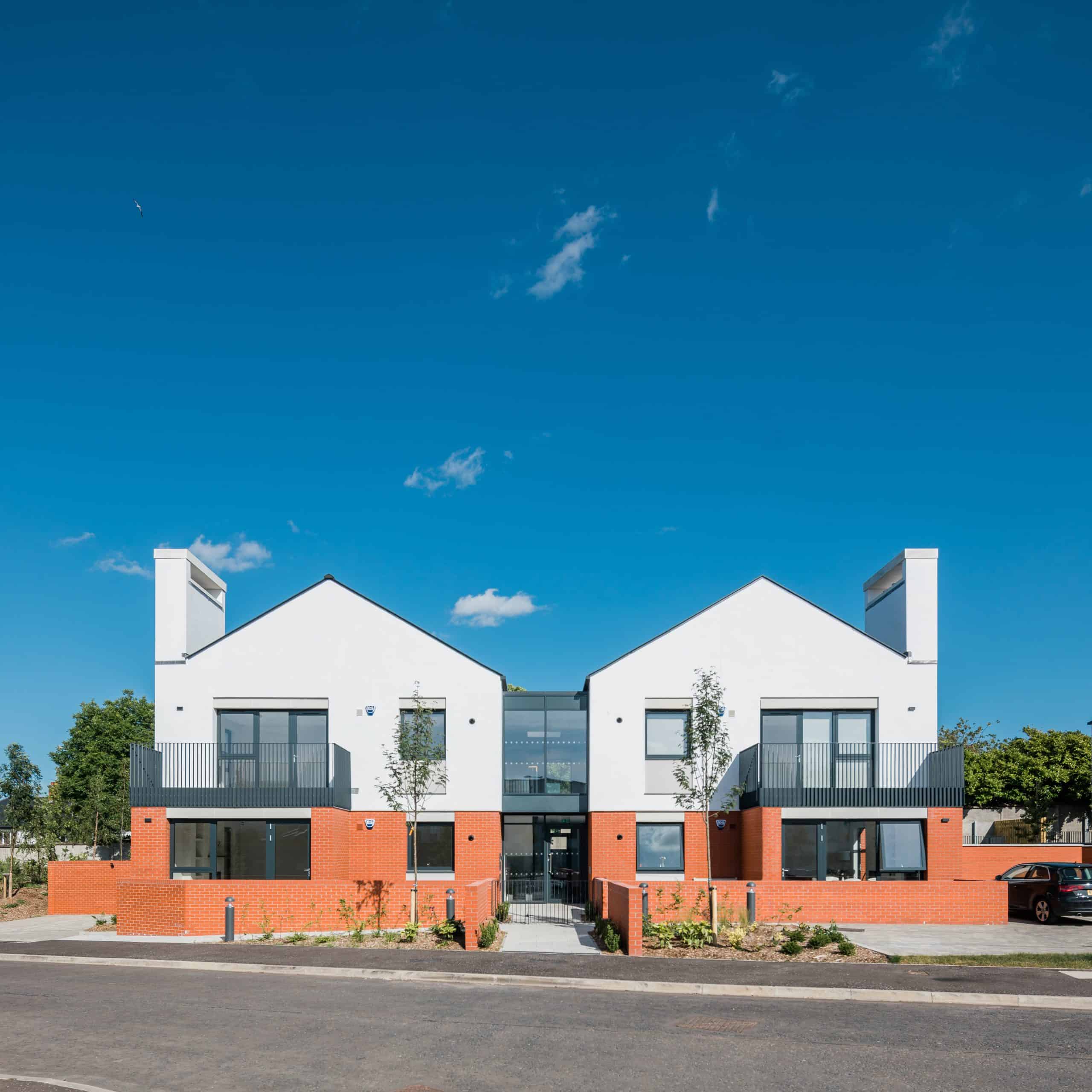
Independent ‘Later’ Living (Plot 5)
Forming a transition to the established residential area, this plot is part of the homes for later living that are incorporated within the site.
Specifically designed for the over-55s, these generous apartments are arranged in groups of four units, served by a shared lift and stair core. Each unit is spacious, with a consideration of future adaptability to allow residents to ‘age in place’ as their requirements change with age.
Ample storage, cognisant of the needs of ‘down-sizers’, has shaped the design and layout of these units. Every apartment has its own dedicated private external space, either directly off or adjacent the unit.
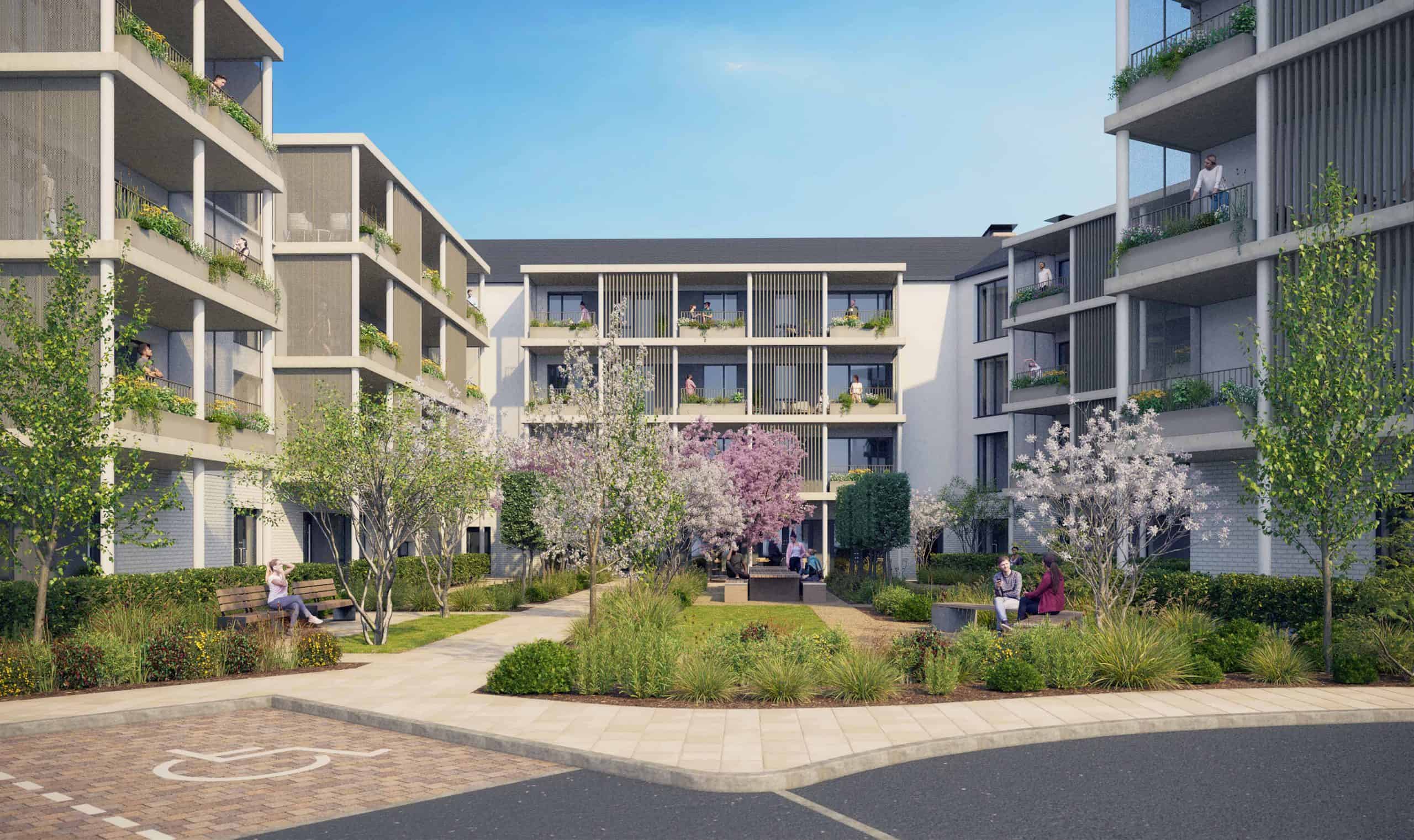
Retirement Living (Plot 6)
These units are located besides, and benefiting from views of, the Balmoral Golf Club, which adjoins the site and forms part of the residential ‘edge’ to the long-established Harberton residential area.
Following on from the success of Plot 5 this development has consideration for ‘Later Living’ with flexibility and adaptability being incorporated from the outset.
The building’s massing has several conscious ‘steps’ in the form, allowing for large private roof terraces and access to external spaces. As with the other plots, dedicated parking is provided within the site.
Simply Me Crèche (Plot 7)
This single-storey ‘Scandinavian Style’ pre-school was located on the site prior to the development commencing. This use was accommodated within the evolving Masterplan and integrated to bring another very different use to the site.
Co-located with retirement living and adjacent Dataworks this use enlivens the campus.
Multi-Storey Car Park (Plot 8)
The multi-storey car park (six storeys) includes local retail, café & restaurant and leisure uses at its ground floor and fronting onto the Central Plaza space.
The incorporation of this element within the masterplan provides a significant car parking capacity, and limits the surface requirement for parking across the scheme, which has accordingly been given to landscaping.
The masterplan for the King’s Hall Health & Wellbeing Park sets a benchmark for community-integrated health and social care and suggests a fresh, healthcare-led approach to urban renewal. With placemaking at its heart, it has been designed to encourage social connection, promote healthier lifestyles and foster an entrepreneurial health community.
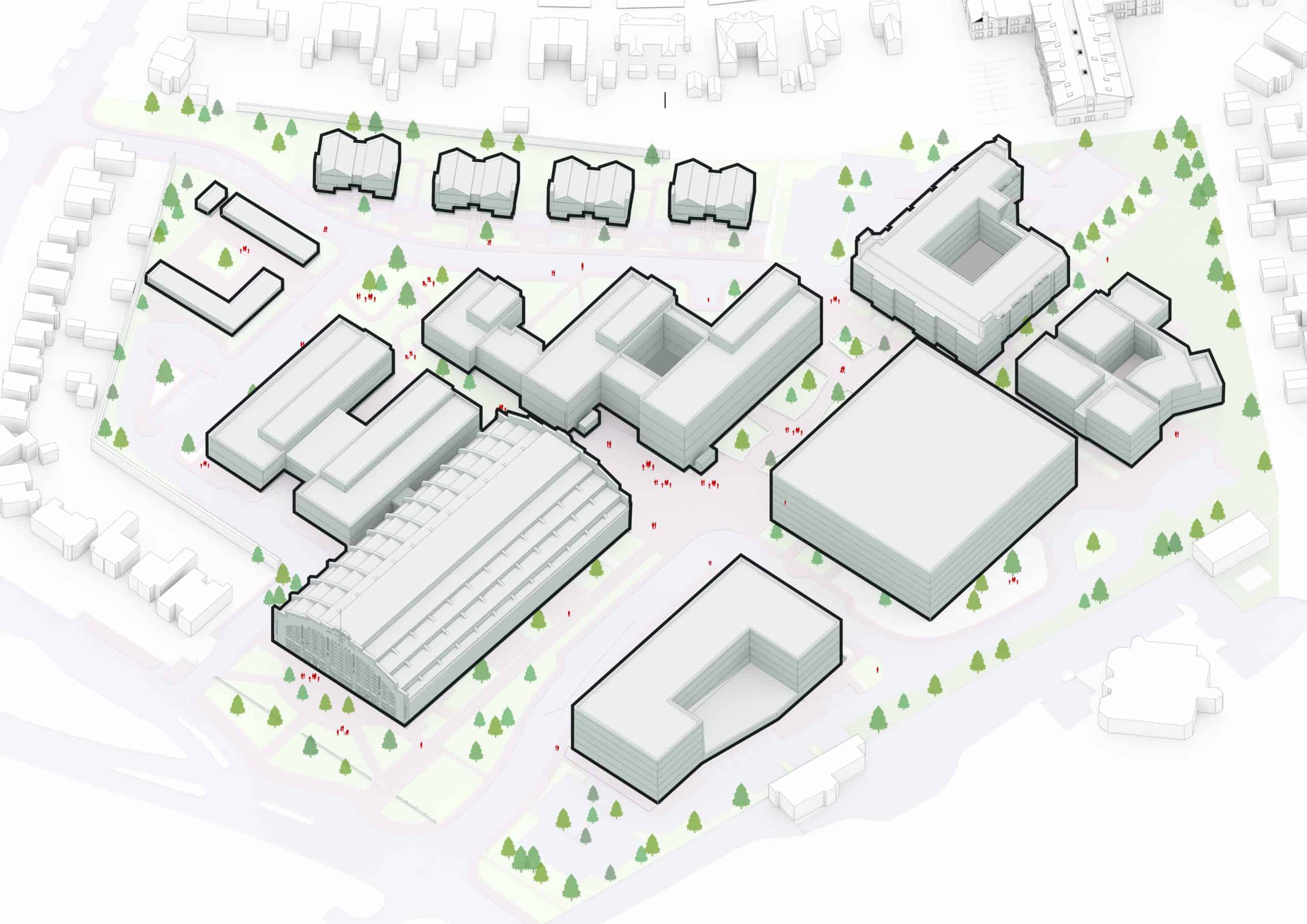
Encouraging social connection
The benefits of social connectivity for mental and physical wellbeing have been well proven, with one landmark study from University of Michigan showing that lack of social connection is a greater detriment to health than obesity, smoking, and high blood pressure. Social connectedness is especially important for promoting health later in life, yet many traditional later living and care communities in the UK are often isolated in remote or rural locations. However, the senior demographic is rapidly changing and many older people now want to continue living in urban and suburban areas, close to amenities where they can maintain friendships and participate in community activities.
Our masterplan for the King’s Hall Health & Wellbeing Park outlines how later living and healthcare needs can be integrated into the local community with the ability to share or co-locate facilities where practical. The Kings Hall scheme adopts a fully connected, interrelated urban context. It posits a new form of urbanism driven by health and wellbeing, planned and designed around social inclusion to create a development where all ages can live side by side, benefiting from the social, cultural and economic opportunities of a multigenerational diverse community.
A good example of the multigenerational diversity at King’s Hall Health & Wellbeing Park was our introduction of a kindergarten to the overall masterplan. Whilst not originally envisaged to be part of the scheme, as the development design evolved a local need was identified with an existing kindergarten provider relocating to another part of the site.
A recent report by United for All Ages suggests that children who regularly mix with older people see improvements to their language development, reading and social skills, whilst older people’s interaction with children helps lessen symptoms of loneliness and isolation. Although the kindergarten is entirely separate to the later living and care provision, its close proximity to these facilities will allow the school to fulfil its plans to further intergenerational care. One of the central planks of its vision is to establish close links with the new facilities for older people on the site to offer mutual psychological benefits and learning experiences for young and old alike.
Spaces that promote healthier lifestyles
Our design for King’s Hall Health & Wellbeing Park opens up a previously closed-off area of south Belfast and gives it back to the people of the city. A new park has been created at the centre of the whole scheme and all the main components have access to it ensuring permeability and connectivity throughout the whole site.
The public realm spaces for the development of the wider King’s Hall development play a vital role in creating a character and sense of place within the new development, whilst also being sympathetic to the local heritage. Our aim in the design has been to create an attractive, safe and healthier environment where people want to live, work and visit.
In looking to address some of the wider determinants of health, public spaces have been purposefully designed to encourage walking and cycling, as well as social connection; facilitating such behaviours is an essential component of the healthcare-led masterplan, delivering low-cost, high-value benefit for individual physical and mental health whilst also reducing the burden on the NHS of treating preventable illnesses. Public and private spaces between buildings, alongside the central plaza featuring cafés and retail outlets, encourage connection and the promotion of active travel throughout the site. Cycle stands are located at important locations in order to provide cycle provision for each of the plots throughout the overall masterplan.
For those looking for relaxation and contemplation, a pocket park has been introduced, providing a passive setting with a wide variety of evergreen, deciduous and herbaceous planting all of which provide seasonal interest. Good access and minimal changes in level will ensure use of the park for all user groups, whilst lighting means the space can be used in the evenings and help with passive surveillance of the area.
An entrepreneurial health community
An important component of the King’s Hall masterplan, and key to unlocking the collaborative potential of the site and optimising the delivery of benefits, is the inclusion of Dataworks, a commercial hub totalling over 40,000sq ft. The hub is now anchored by precision medicine and data analytics firm Diaceutics and provides a secure and collaborative space for companies to focus on the rapidly growing and highly valuable healthcare data market.
Funding for the site infrastructure and Dataworks development has been provided by the Northern Ireland Investment Fund, a £100m Fund which provides debt finance for real estate, regeneration, low carbon and infrastructure projects.
Leveraging the smart city concept, Dataworks sits in direct proximity to healthcare professionals serving patients within the park and alongside Belfast’s major hospitals and universities and innovative medical research facilities.
The combination of a vibrant and entrepreneurial health community, a large talent pool of scientific minds and proximity to healthcare professionals treating patients, top universities such as Queen’s and University of Ulster makes Dataworks a new spatial model for Life sciences companies.
The offer to collaborate is expected to become a significant draw for other precision medicine companies from around the world which will help to fulfil the ambition of Dataworks to become a fully collaborative space where knowledge, research and expertise can be shared to unlock the promise of precision medicine globally.
According to an economic impact assessment, the King’s Hall Health and Wellbeing Park will boost the Northern Ireland economy by £47 million a year and support 640 full-time equivalent jobs.
Healthcare-led urban renewal
In co-locating social and economic activity, alongside access to quality public realm, the scheme also addresses the wider determinants of health and is a role model for reducing health inequalities that exist in many urban centres. In this regard, Kings Hall Health & Wellbeing Park identifies a healthcare-led solution for public authorities to work in partnership with the private sector to revitalise their city centres post pandemic. The Health & Wellbeing Park is a replicable model and robust enough to respond and evolve to place-specific needs or tenant requirements.
One of the biggest stumbling blocks to delivery is the availability and cost of land in prime and populous urban areas where the competition from residential can see sites quickly snapped up. Where land is in short supply, the model can become denser, building vertically rather than horizontally. One only has to look to Australia where ‘vertical villages’ have been the norm for some time in the retirement living sector, partly responding to retirees’ desire to be live near vibrant urban centres, close to shops, restaurants and cultural opportunities. According to the Property Council of Australia’s 2021 Retirement Living Census, 41 percent of new later living developments in 2020-21 were classed as ‘vertical’ in nature.
Building vertically permits more people to live in a serviceable area and allows more businesses and services – health or otherwise – to operate in the same building or nearby. It’s a win-win situation, the economies of scale ensuring the affordable delivery of health services whilst also increasing the possibility that residents’ demands will be addressed.
Whilst there are perhaps some design challenges in the co-ordination of different uses and potential planning bureaucracy with regard to bringing different use classes together, such dynamic residential, lifestyle, leisure and wellbeing hubs present significant potential to bring a sense of vitality and excitement to communities with their mix of uses.
At the King’s Hall Health & Wellbeing Park, for example, we have included a range of small-scale local retail outlets at key locations throughout the site to help animate the street frontages and support a vibrant and energetic development. The incorporation of a range of residential developments types promotes active functions throughout different times of the day and, by combining the residential and non-residential uses within one development, active frontages and public surveillance is enhanced to create a lively and safe environment.
Adaptive re-use to unlock opportunity
In urban centres, where the shift to homeworking and the growth of internet shopping, has seen some high streets devastated by the closure of shops and office buildings, it would be reasonable to assume that the adaptive reuse of these redundant spaces could also form part of the plan, as our adaptive re-use of the iconic King’s Hall building proves. These spaces are not only accessible and serve a large patient population, but their configuration and ceiling heights often make them easily and immediately adaptable, whether to modular operating theatres or to accommodate vital equipment for diagnostic purposes, such as MRI scanners.
Using ailing high streets and shopping centres to create a later living community, around which are focused a range of integrated health and support services, can bring a critical mass of people back into town centres to unlock socio-economic opportunity and investment. In addition to being able to walk to a café to meet with friends, go to the local cinema and play an active role in the community, having easy access to healthcare provision could be a positive influencer in bringing footfall back into town centres, whilst life sciences and healthcare businesses open up employment opportunity. In this sense, healthcare-led proposals can play an important role in allowing high streets to rediscover their social purpose and reconfigure as ‘community hubs’, as retail guru Bill Grimsey has argued they must to survive.
Conclusion
The development of King’s Hall Health & Wellbeing Park reveals how public- and private-sector organisations can work together to unlock wider urban renewal by placing healthcare at the centre of regeneration strategies. In creating a destination that combines residential, lifestyle, leisure and wellbeing, the King’s Hall Health & Wellbeing Park fosters a place for culture, community and prosperity that can improve social cohesion, health equity and economic opportunity for all.
 close
close